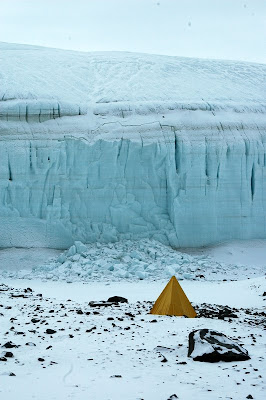It happened. I finally made it. I've got dirt in the treads of my keds from the mainland of Antarctica. So close but so far away, I had only ever been either on an island or atop an ice sheet, miles from the continent.
If only my nefew could see me now! Hi Sam!
The Taylor Valley is the most researched area in the dry valleys, across the Ross Sea from Mactown, it is a quick hop in a helicopter-about 30 minutes. Having never ridden in a 'helo' before my two trips out there, getting there is half the fun! We have some great pilots down here and they aren't afraid to use their skills! (some of the other folks on the trip didn't have as good of a stomach for that kind of thing though...) The dry valleys are thus named because they get very little precipitation, and, though surrounded by intruding glaciers, the valley leaves exposed the bare dirt of the continent, a rare occurance. Though the glaciers are flowing into the valleys, they don't make it far before seasonally melting back to the previous summer's location.
So this brings me to the most dominant feature of the dry valleys. With all this melting of course there run seasonal streams which flow into... lakes! The dry valleys really are not that dry after all! Under fairly permanent layer of ice, these ultra saline lakes contain life! Only really small things of course, but bacteria, fungi, plankton and others make for a primitive but promising model. The ice atop the lakes is an amazing sight to see, but be damn careful! It's like walking on a table cloth that someone is in process of pulling out from under the dishes! I've never walked on such a slippery surface. Our helo pilot warned us - be careful. It's more slippery than Owl shit out there. It's also the coolest ice I've ever seen, and at this point I'm starting to feel like an expert on ice. I could tell you about how clear and amazing it is, but here are pictures instead. I will say that I picked up one loose piece of ice off the lake top, about the size of a rolling pin, and I think it was clearer than the clearest glass I've ever seen.






Ice from the edge! The edges of the lakes melt every year, and refreze flat and crystal clear. Come spring they crack in some of the most amazing ways. These cracks are from the surface to several feet deep, thought the pics are pretty flat.


Some bubbles bubbling up? somehow? I'm pretty sure I would like to enroll in a week long class about the lake ice formations.


Rumpley top, cut by the wind and the sun? Stalagmites/hoodoos left when lake ice melted around them.
Scientists in the valleys study the life going on here, the glaciers, the rocks, and the whole idea that this is pretty much Mars. Or at least Europa, Jupiter's ice covered moon. Endurance, the project that is geared toward this similarity has a nifty robot that they are exploring the lake Bonney with that is a prototype of sorts for one headed out to Europa maybe in the next decade?? Pretty wild stuff. Around here they still get to pull it out and fix it when it breaks, and have thus learned alot about what might work all the way out there.


This is where the Endurance Robot lives (This is the kind of tent we build for all sorts of science related shelters.) and this is the robot being fixed (you have to get out the kinks before you go all the way to Jupiter!)
Now... for the quick-quick-I'm deploying to the deep field in 24 hours and have to pack version...
(story to come in three weeks when I return)
(story to come in three weeks when I return)
Lake Bonney, Canada Glacier at Lake Hoare Camp

Oh yes, and what in the world was I doing there? Fixing outhouses and drilling new ice anchors for and maintaining various shelters! Definetally a great job! Look at that smile!





































